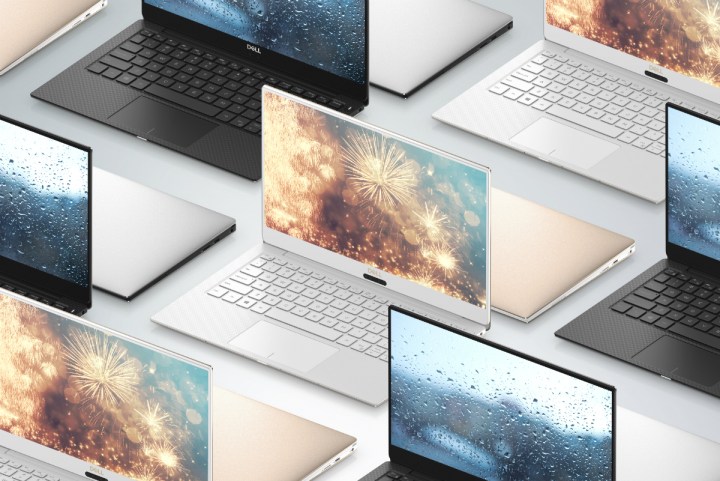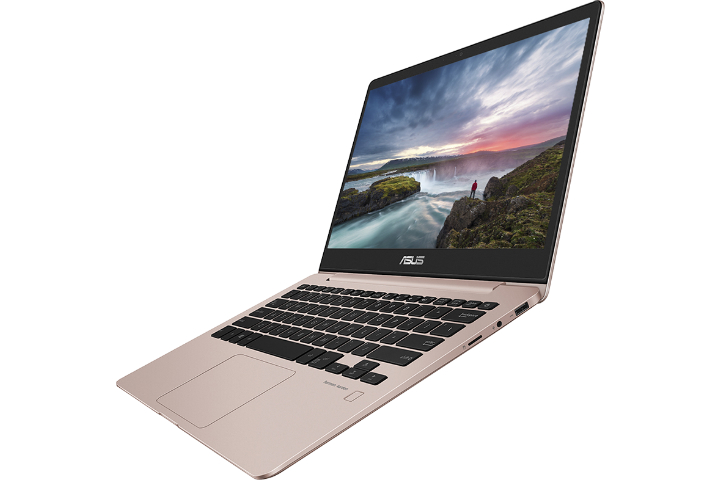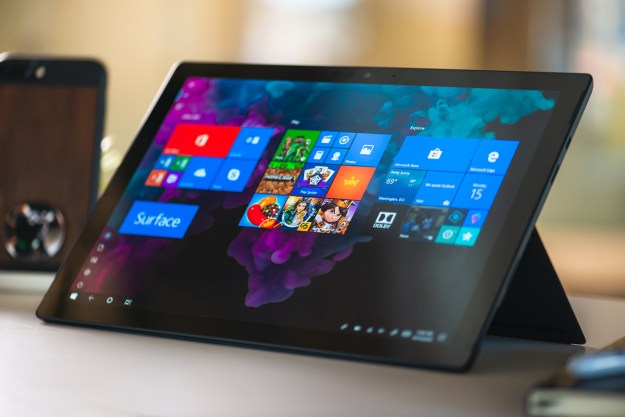
Both machines sound like they offer some nice capabilities for anyone who just needs a notebook without any 2-in-1 flexibility. We compare the Dell XPS 13 vs. Asus ZenBook 13 to see which portable and powerful notebook is the right one for you.
Design
Dell’s XPS 13 has always sported a thin and very robust design, with aluminum providing rigidity to the chassis and strong carbon fiber lining keyboard deck for a comfortable experience. The updated model maintains the same basic design in its black variant, but it has been chiseled down to be even thinner (0.46 inches at its thickest point) and lighter (2.67 pounds). There is also a new version with a Rose Gold aluminum lid and Alpine White keyboard deck that is made with a special glass fiber material specially designed for Dell. In addition, Dell commissioned a Gore Thermal Insulation material that promises to move hot air out of the chassis more efficiently to keep performance up. It’s a high-tech design that looks great — and we love it.

The Asus ZenBook 13 is a more traditionally designed machine, with an all-metal chassis that should be solid and robust if it follows the company’s general practices. It’s a good looking notebook, with royal blue and slate gray color schemes and the iconic Asus spun-metal design. Asus refers to the ZenBook 13 as enjoying a “luxurious crystal-like gloss coating” and uses a non-imprinted lithography process to achieve it. The ZenBook line is generally full of good-looking notebooks and the newest member follows the trend — while creating a very thin and light notebook at 0.5 inches and 2.17 pounds.

We can’t fault Asus for going with a more tried-and-true design with the ZenBook 13. At the same time, we have to give some kudos to Dell for incorporating some nice technologies in refreshing the XPS 13’s look and feel.
Winner: Dell XPS 13
Performance
Dell made some real changes to the XPS 13’s chassis in the newest version, but it kept the brains of the machine largely intact. The company recently refreshed the line with Intel’s quad-core eighth-generation Core i5 and i7 processors, and those components remain the same this time around. That is coupled with up to 16GB of RAM and up to a 1TB PCIe solid-state drive (SSD). In our experience, that means you get solid productivity performance and even some extra power for things like encoding video. For its part, Asus has followed suit with the ZenBook 13, using the same eighth-generation Intel Core i5 or i7 CPU, up to 16GB of RAM, and up to 1TB SSD.
We were impressed with Intel’s latest 15-watt CPUs for their great performance and enhanced efficiency. Both the XPS 13 and the ZenBook 13 offer similar parts and so performance should be relatively equal — they will both do a great job with even higher-end productivity tasks.
Winner: Tie
Keyboard, mouse, and pen
The XPS 13’s keyboard has long been comfortable to type on, with decent travel and snappy response. We don’t expect that to change in the new version. Dell’s touchpad is also excellent, with Windows Precision Touchpad support for reliable gesture support. For more convenient security, Windows 10 Hello support is provided by a fingerprint scanner on the keyboard deck. Finally, the XPS 13 has a touchscreen option for those times when you just want to tap a button or scroll a web page.

Similarly, the ZenBook line has generally managed to fit a responsive keyboard into thin chassis, and the ZenBook 13’s version is likely to be just as good. Asus also opts for Windows Precision Touchpad support, promising the same quality experience when mousing and gesturing in Windows 10. The notebook also uses a fingerprint scanner, also located on the keyboard deck, for Windows 10 Hello. Finally, the notebook also sports a touch display for convenience.

There is nothing to separate these two thin and light notebooks in terms of getting information into them. Both will likely provide great experiences and so we have to call this category even.
Winner: Tie
Connectivity
Dell had to trim the port selection on the much-thinner 2018 version of the XPS 13, dropping the USB-A ports that adorned the previous models. Now, there are two USB-C ports with Thunderbolt 3, one USB-C 3.1 port, and a microSD card slot. That means that you’re covered for future connectivity, but you need dongles to plug in your older peripherals. Of course, there is the usual 2×2 MU-MIMO 802.11ac Wi-Fi and Bluetooth radios to keep you connected wirelessly.
The ZenBook 13 manages to retain two USB-A 3.0 ports and an HDMI connection for legacy support, and it adds a USB-C 3.1 port to connect to newer devices. It’s not a Thunderbolt 3 port, however, which means its capabilities will be more limited. There is also a microSD card reader and the usual Wi-Fi and Bluetooth connectivity.
We like that the ZenBook 13 supports legacy devices out of the box, but the lack of Thunderbolt 3 support is disappointing. You need dongles with the XPS 13, but you will appreciate the faster connection down the road.
Winner: Dell XPS 13
Display
Dell seriously upped the ante with the newest XPS 13’s display options, switching from a 13.3-inch QHD+ (3,200 x 1,800 or 276PPI) panel to a full 4K UHD (3,840 x 2,160 or 331PPI) option. And it looks like Dell is pulling down the quality from the great display on the older XPS 15, with the smaller model now sporting the same 100 percent sRGB color gamut and 1500:1 contrast ratio. There’s also a Full HD (1,920 x 1,080 or 165 PPI) display available for anyone who values cost and battery life over the ultimate in display quality.

Asus is offering a lesser Full HD option, and in our experience, their displays are usually right around average in terms of color support and contrast. That is not a bad thing, as today’s “average” display is significantly better than good displays of just a few years ago. But the lack of a 4K UHD display option is a bummer.

This is one area where the Dell is likely to offer a significantly better experience. If great colors, high contrast, and 4K are important to you, then the XPS 13 is likely to be the better option.
Winner: Dell XPS 13
Portability and battery life
Another area where Dell needed to cut in order to fit into the thinner chassis is battery capacity. The old model packed in 60 watt-hours of battery, and the new model drops down to 52 watt-hours. That’s not terrible, but it’s likely to have a significant impact particularly with the increase a 4K display. Dell is promising up to 19 hours and 46 minutes of battery life, and certainly, the new eighth-generation Intel processors are more efficient, but you’re likely to see less than that and only with a Core i5 and Full HD display.
Asus is more conservative with its own battery life estimates for the ZenBook 13, promising “only” 14 hours. The machine has 50 watt-hours of battery capacity, which is just slightly less than the Dell. However, the ZenBook 13 does include a more powerful GPU, which will burn more battery life whenever it’s utilized. That’s optional, however.
We don’t think it’s fair to penalize Asus for giving the option of burning more battery power. These two look close enough that we’ll have to wait to review them to award a real winner.
Winner: Tie
Availability and price
The new XPS 13 starts out at $1,000 for a Core i5-8250U CPU, 4GB of RAM, 128GB PCIe SSD, and Full HD non-touch display. That is a $100 jump from the older model, and the new configurations ramp up to a significant $2,050 for a Core i7-8550U, 16GB of
Asus has not yet announced pricing on the ZenBook 13, and so we can’t make a direct comparison. And it is hard to predict how the machine will be priced because Asus has offered some machines that we’ve thought were very well priced for the design and configuration, and some that we’ve thought are priced a little too high.
Winner: To be determined
Dell takes the prize for pushing the technology envelope
Dell took a machine that we’ve been calling the best 13-inch notebook and made it better. It’s thinner, lighter, faster, and uses some fairly exotic materials to made it sturdier and perform better. Asus has made a nice-looking notebook in the ZenBook 13 and it packs in a nice GPU, but otherwise, it’s a fairly traditional offering.
We do like our technology, and so we’re going to give the victory in this comparison to the Dell XPS 13. But we wouldn’t hesitate to recommend the Asus ZenBook 13 if you really need some extra graphics power.
Updated: Clarified some Asus specifications.
Editors' Recommendations
- HP Envy x360 13 vs. Dell XPS 13: the best tiny laptop?
- Asus ZenBook S 13 Flip vs. HP Envy x360 13: it comes down to price
- Dell XPS 13 2-in-1 vs. Surface Pro 8: New competition
- Microsoft Surface Laptop 3 vs. Dell XPS 13
- Razer Book 13 vs. Dell XPS 13


